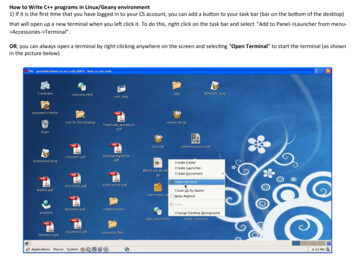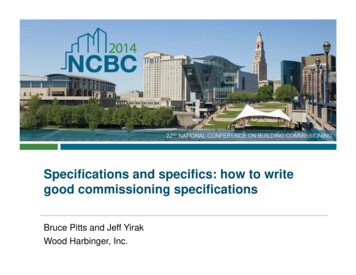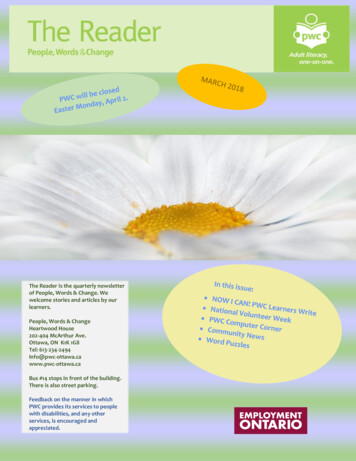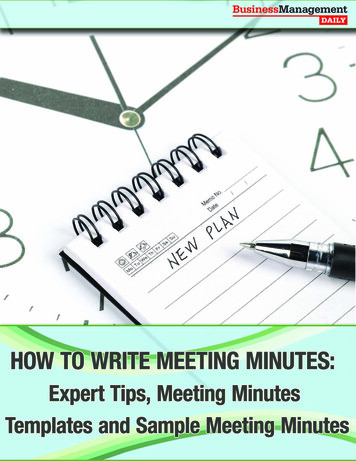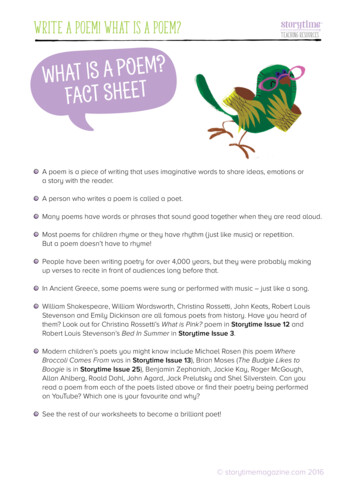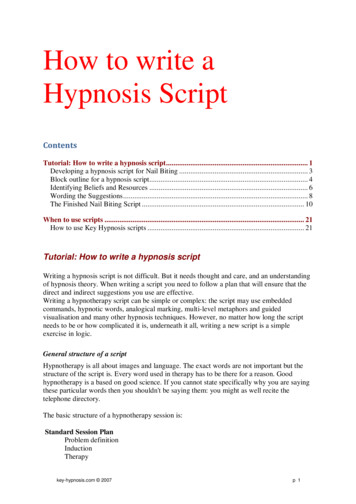
Transcription
How to write aHypnosis ScriptContentsTutorial: How to write a hypnosis script . 1Developing a hypnosis script for Nail Biting . 3Block outline for a hypnosis script. 4Identifying Beliefs and Resources . 6Wording the Suggestions . 8The Finished Nail Biting Script . 10When to use scripts . 21How to use Key Hypnosis scripts . 21Tutorial: How to write a hypnosis scriptWriting a hypnosis script is not difficult. But it needs thought and care, and an understandingof hypnosis theory. When writing a script you need to follow a plan that will ensure that thedirect and indirect suggestions you use are effective.Writing a hypnotherapy script can be simple or complex: the script may use embeddedcommands, hypnotic words, analogical marking, multi-level metaphors and guidedvisualisation and many other hypnosis techniques. However, no matter how long the scriptneeds to be or how complicated it is, underneath it all, writing a new script is a simpleexercise in logic.General structure of a scriptHypnotherapy is all about images and language. The exact words are not important but thestructure of the script is. Every word used in therapy has to be there for a reason. Goodhypnotherapy is a based on good science. If you cannot state specifically why you are sayingthese particular words then you shouldn't be saying them: you might as well recite thetelephone directory.The basic structure of a hypnotherapy session is:Standard Session PlanProblem definitionInductionTherapykey-hypnosis.com 2007p 1
ReorientationProblem DefinitionDefining the problem is the most critical of the therapist's skills but it is not dealt with here.Bad hypnotists apply the same script to everyone - and then are surprised when they don't getresults. Scripts have to be designed individually to address the particular problems andresources of each client. Clients frequently tell you their problem is one thing, but when youtalk to them it turns out to be something quite different. Therefore identifying the actualproblem is the first stage.InductionInductions are generally simple and standard. The induction may be preceded by a test forsusceptibility and a test for preferred representational style. (The induction will need to be reworded if the client turns out to be unable to visualise, for example). The induction processusually involves a combination of induction suggestions, one or more deepeners and one ormore tests for depth of trance. For examples see the section on inductions and deepeners inthis collection. Most published therapy scripts omit the induction section because eachtherapist will usually use their one or two favourite induction routines with every client.Induction SectionDevelop RapportNote Representational StyleSusceptibility test (optional)InductionDeepener(s)Depth Test(s) - EssentialTherapyThe therapy section depends on the nature of the client's problem. Therapy can be basedaround Regression, or Parts Therapy, or Metaphor or Guided Visualisation or anycombination of these techniques and more. For a standard session, (if there is such a thing!)the following structure could be expected.Therapy SectionAccepting ChangeNew Ways of thinkingReconnection to resourcesNew Capability BeliefsNew Identity BeliefsSelf Esteem BuildingDeletion of Old BeliefsReinforcement of hypnotic messageReorientationkey-hypnosis.com 2007p 2
After the therapy the client has to be brought back to the present and left alert and clearheaded. Most therapists have a favourite style that they always use so most published scriptsdo not detail the reorientation text.Developing a hypnosis script for Nail BitingThe next part shows how to write an original hypnosis script.The basic logic is:First identify the exact problem as the client experiences it,then create a block outline for the hypnosis script,then identify the client's assumptions and resources, and finallytailor the hypnotic words and phrases to suit the particular client.The exact transcript of the live session is given later in this section to show how anexperienced therapist created an original and unique script based on the block outline.The following sections describe how I created an original Nail Biting hypnosis script for aclient I had never met. All I knew about him was that on the telephone he told me he wantedto deal with a Nail Biting problem.The first thing to consider when thinking about changing a behaviour with hypnosis iswhether the behaviour is triggered by a specific situation, or whether it is a chronic problemthat seems to be in operation all the time. The two different types of problem require differentapproaches. Nail biting has a bit of both. Nail biting is a conditioned behaviour originallytriggered by stress, but now maintained and reinforced by constant repetition. The client isusually doing the biting or chewing with no conscious awareness of how or when thebehaviour started. The basic purpose of the Nail Biting script therefore is to make the clientmore aware of what their hands are doing, so that they can interrupt the cycle, and to increasethe client's awareness of what their hands should look like as a constant reminder to them(see the Cycle of Behaviour page for an overview of behaviour triggers). Parts of the scriptalso address issues of self esteem, expectations of success, and embarrassment aboutappearance.Writing a hypnosis script consists of four stages:1.2.3.4.Deciding on the areas to targetDesigning the Block OutlineIdentifying Unique Resources and BeliefsWording the Direct and Indirect suggestionsDeciding the areas to targetWhat needs to change?The first step is to consider what behaviours are to be targeted, and what beliefs need to bechanged to ensure that the new behaviour sticks. With nail biting the source of the stress is farin the past, and may in fact have disappeared long ago. There is no point in seeking theoriginal source of the stress. What needs to be done is to deal with the consequences.What is maintaining the negative behaviour?key-hypnosis.com 2007p 3
The second step is to consider what might be maintaining the behaviour. Any behaviour thatis causing distress but which is still going on must be getting rewarded in some way. In NailBiting the reward is a distraction behaviour that gives the impression of control, control of thestress. It is likely that the subconscious thought along the lines of "I can't control the eventsaround me, but I can get some comfort from putting my fingers in my mouth". It is only shortstep from there to nail biting, then to an association that biting the nails is how to respond tostressful situations. This belief must be eliminated or the behaviour will start again the nexttime a stressful situation is encountered.What resources does the client have?The third step is to consider what resources the client has that can be utilised to help ineliminating the problem. The client typically has tried to stop biting their nails and couldn't,so there is a history of failure. This belief needs to be replaced by a belief in their ability tochange, and to be successful. Each client is different and brings different strengths with them.Before meeting the client you can only use strengths that all clients can be expected to have memories of past successes, and evidence of personal control in some aspects of theirbehaviour. These would then be magnified and expanded to reconnect with lost resources.How does the client represent their problem?Each client will experience their problem in a unique way, but people are similar enough tobe able to predict how common problems present themselves mentally. In this case the clientprobably has an image of bleeding, ugly, useless nails that are a constant embarrassment.This needs to be changed to something positive. Guided visualisation will ensure that the oldimages are replaced by attractive images.The client probably feels bad about their nails, their fingers and their hands in general. Thescript needs to make the client feel good about them again.Block outline for a hypnosis scriptCreating the Block OutlineBefore he arrived I blocked out a script outline for the nail biting script, this defines thesections to be covered, each aimed at one particular aspect of the problem. (These are shownbelow in boxes).InductionUse a standard inductionAIM: achieve trance statePacingValidate the problemEmpathise with the clientAIM: Communicate Rapport and RespectRecall past successesCall up past successesExperience the feeling of successParty VisualisationBlessings of important peopleAnchor that feelingkey-hypnosis.com 2007p 4
AIM: IDENTITY - Self EsteemAIM: CAPABILITY - "you can change"Recall control experiencesCall up past control instancesConnect to the feeling of controlEmphasize personal controlAIM: IDENTITY - " you are in control"VisualisationsVarious ENVIRONMENTSIn a GroupRespect of friendsPointing and GesticulatingManipulating ThingsPicking up coins, thread, sticky tapeHolding a glassFocus on HandsBuying a watch, ringsPlaying cardsUsing nailfile, cleaningAIM: BEHAVIOUR - situation specific stimuliAIM: IDENTITY - "you deserve good nails"AIM: FUTURE - you enjoy using handsAIM: MEMORY - positive associationsMountain metaphorStrength, PowerInevitabilityAIM: CAPABILITY - Inevitable OutcomeAIM: PHS - Reminder of StrengthPleasure and prideDirect SuggestionIndirect SuggestionAIM: IDENTITY - Self EsteemAIM: CAPABILITY - "You can succeed"AIM: EVALUATION - Positive outcomesAIM: RESPONSE - Feel good about selfPost hypnotic suggestionsMoving Hand looks hugeLike bunch of bananas boxing gloveTaste aversionkey-hypnosis.com 2007p 5
Finger tastes revoltingHands are unhygienicMuscular distortionIrresistible Force forces hand downFinger feels huge in the mouthAlternate BehaviourDeep BreathingRelease tensionAutomatic RewardRush of good feelingsReminder of prideAIM: SENSORY DISTORTION: alterVision, taste, touch, muscular, emotionAIM: STIMULUS - Awareness of handAIM: RESPONSE - Positive FeelingsAIM: REPERTOIRE - Replacement BehaviourSummary and restatementDirect SuggestionsSuggestion RepetitionsAIM: IDENTITY - Valuable PersonAIM: CAPABILITY - "You can succeed"AIM: REPERTOIRE - New replacement actionsAIM: MEMORY - Reconnect to successesSelf convincerGet client to commit to the changeAIM: IDENTITY - New PersonAIM: CAPABILITY - "Convinced I can do it"ReorientationIdentifying Beliefs and ResourcesThe Block Outline is a general purpose solution to a generic problem. Once I actually met theclient I got him to describe how he experienced his problem and I made a note of anyresources he mentioned and any beliefs he expressed about his problem.Nail biting is a common problem that is easily treated with hypnosis. Even though theproblem is common, hypnosis will work better if it is tailored to fit the exact experience ofeach client. Everyone experiences their problem in their own unique way. This part of thetutorial shows how to identify beliefs and resourcesIn order to understand the behaviour of nail biting it is necessary to identify how the clientexperiences the problem, and to find out what resources and barriers the client has. Thiskey-hypnosis.com 2007p 6
checklist of questions is used to prompt the therapist and helps to reveal why, when and howthe client bites or chews their nails. It may also identify resources the client has that can beused against the nail biting habit. These answers provide a set of precise targets and resourcesunique to the client that can be used during hypnosis.Nail biting: ResourcesTarget AreaHISTORY of NAIL BITINGWhen did you start?Why did you start?How often do you do it?Memory, SituationBeliefsBehaviourCURRENT PATTERNS OF NAIL BITINGWhen do you bite or chew your nails?What do you like about it?What do other people think about your nail biting?How do you know when to start and when to stop?Triggers, SituationsBeliefPeer pressure resourcesEnvironment, TriggersRESTARTINGHave you ever tried to give up?Why did you stop?How did you stop?How long did you stop for?Why did you rs & SituationRESOURCESPersonal Experience - stoppingWhat have you tried?Other people's experienceWhat is the worst thing about nail biting?Will other people support you to EFS ABOUT NAIL BITINGWhy do you do it?Why don't you just stop?What do you think when you see other people nailbiting?Is there anything would stop you stopping?Identity, BeliefsIdentity, BeliefsBeliefsBeliefsMOTIVATIONWhy do you want to stop now?How do you know you can stop now?What will others think when you stop?Beliefs, negative &positiveCapabilityResourceBEHAVIOUR AFTER STOPPINGkey-hypnosis.com 2007p 7
What will be different when you stop?What will you be able to do when you stop?What will other people say when you stop?What will your nails look like when you stop?What are you going to do instead of nail biting?What will be the biggest benefit?Capability, RewardsVisualisation, CapabilityResourceVisualisationAlternative behavioursMotivation ResourceThe therapist would not normally ask all these questions directly. Most of the informationwill be provided when the client describes how they experience their problem. The check listis just to ensure that no potentially useful areas are misse
Developing a hypnosis script for Nail Biting . The next part shows how to write an original hypnosis script. The basic logic is: First identify the exact problem as the client experiences it, then create a block outline for the hypnosis script, then identify the client's assumptions and resources, and finally



